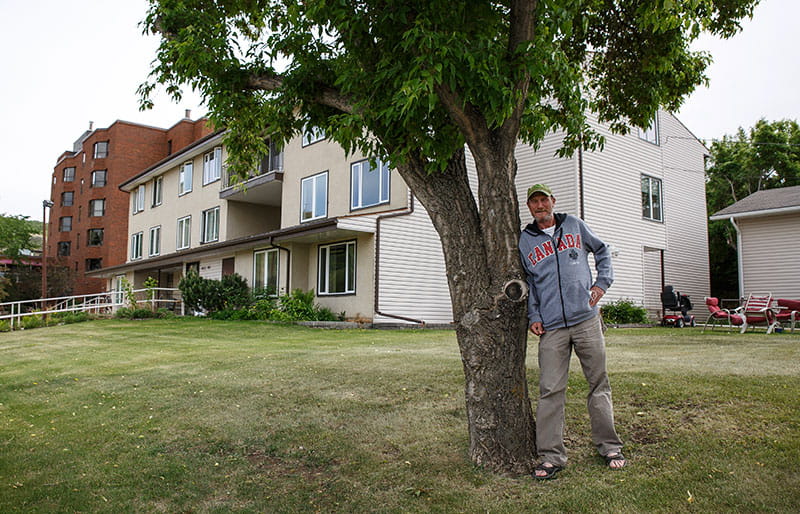
July 7, 2021
Guide brings Canadian rural homelessness into focus
In early 2020, Cecil Scofield, 56, was living in a shelter in Peace River, Alberta. The former welder and oil rig worker suffers from chronic health issues that left him unable to work.
“You can’t live out on the streets in the winter here,” says Cecil. “It can get to -40⁰C.”
When the shelter reduced its beds to meet COVID-19 protocols Cecil was forced to move. He spent the spring and summer sleeping under a bridge of the small rural town. In the fall, he stayed in an abandoned truck near the town’s CO-OP store. Finally, just as winter arrived, he got a one-bedroom apartment in subsidized housing.
Of his new home he says, “It’s a pretty sweet set up. I’ve got new floors, fresh paint, a new tub. Some people donated a couch and other furniture.”
Traditional information-gathering tools fall short
Stories like Cecil’s are more common than many rural communities realize. Homelessness tends to be hidden. People may be living in campgrounds, cars and trucks, or couch surfing with friends or family.
A new award-winning tool, the Step-by-Step Guide to Assessing Rural Homelessness, is helping small Alberta towns to get a clearer picture of their homelessness situation. In turn, this helps them to better plan and make the case for housing and support services. It has been so successful that it is now being used in communities across the country.
The Rural Development Network developed the tool, which recently received a CMHC Gold Roof Award for Knowledge to Action.
The network became aware of the need for the guide through its work delivering the federal government’s Reaching Home homelessness strategy in Alberta.
“More and more, rural towns were telling us that homelessness was an issue,” says Scott Travis, Rural Development Network’s director of research and programs.
“But they didn’t have the tools they needed to gather information about the extent and nature of the problem.”
The standard method of assessing homelessness in most cities is the Point-in-Time approach. This counts the number of people in shelters and sleeping outside on a single night. But, limited resources combined with the hidden nature of rural homelessness, mean this approach is not effective for these communities.
Longer survey yields more accurate results
Rural Development Network’s survey runs over a month-long period. A lead organization generally coordinates it with participating agencies, like food banks or libraries. Everyone who accesses these services is asked to complete the survey. This method is cost-effective, flexible and has a higher rate of engagement and accuracy.
In 2018, Rural Development Network piloted the guide in 20 communities. It was the largest-ever collaborative count of homelessness in rural Canada. It revealed that some 3,000 people lack secure housing. In 2020, the network expanded the study to include 24 communities. Results were published in May 2021.
We found that 30% of people experiencing homelessness had jobs and 13% work full time.
“These studies have taught us a great deal about homelessness in Alberta—and have challenged our assumptions,” says Travis.
“We found that 30% of people experiencing homelessness had jobs and 13% work full time. We also found that ‘rural’ isn’t an umbrella that explains everything. In some coal and mining towns, homelessness is the result of people losing their homes and jobs due to a downturn in the energy sector. But in affluent towns like Banff and Canmore, people are working full time and still can’t find a place to live,” says Travis.
The survey also revealed that Indigenous people and youth, particularly those identifying as LGBTQ2S, were overrepresented in the homeless population of rural communities.
Making the case for new homelessness shelter
Marc Boychuk is a homelessness advocate and was a lead for the Rural Development Network studies in Peace River. He says the data helped to uncover the extent of homelessness in his town. It also helped him to make the case for a new shelter.

“Up until several years ago, I was unaware of the issue. I saw a movie about homelessness and thought—well , thank heavens we don’t have that problem here in Peace River.”
Seeing the movie was a watershed moment. Marc began to notice people living in their pick-ups at a campground, or in makeshift trailers. After meeting many people in this situation, he felt compelled to advocate for them in the hours outside his full time job at a pulp mill. He started a foundation, but found it difficult to convince government and business leaders to support his cause.
“If I had a dollar for every time I heard that there wasn’t a problem... When we got the results from the Rural Development Network study, there was no more arguing it. I was able to show officials that Peace River ranked first in the category of the most people sleeping outside."
There might be anecdotes in a community of people in hard times. But once data is available, it gives it credibility.
The small town of Stony Plain, commuting distance from Edmonton, also benefited from the assessment tool. Sharida Csillag is the town’s community development officer. She agrees that the study helped build understanding of homelessness in the town.
“There might be anecdotes in a community of people in hard times. But once data is available, it gives it credibility,” says Csillag.
Changing the perception of rural homelessness
“The study has also challenged perceptions of homelessness—and the associated stigma. There’s a stereotype of homelessness as a person seeking emergency shelter. Many of the people we surveyed who fit the accepted definition of homelessness didn’t see themselves as homeless,” says Csillag.

“One great surprise from the study was the enthusiasm of the people taking the survey. They wanted to be heard. They wanted their opinions captured. They wanted their data shared. They were very thankful to us for doing the survey and listening.“
In addition to stand-alone projects with communities across the county, the Rural Development Network is planning a 2022 study that will include more remote communities.
“I’m predicting that we’ll learn how to adapt our tool even more for those remote and northern communities,” says Travis.
“Some of these places might not have a central location for services. So how do you reach people there? We’ll also be asking about COVID-19 and the impact it is having on homelessness in their community. Overall, we’ll be exploring how we can adjust and customize our tool so that we can use it on a larger scale and benefit more people,” says Travis.
AT A GLANCE
- The Step-by-Step Guide to Estimating Rural Homelessness was created by the Rural Development Network.
- The guide received a CMHC Gold Roof Award for Knowledge to Action in 2020.
- The guide was initially funded through an innovation microgrant from ESDC. The second edition was funded through ESDC’s Homelessness Partnering Strategy.
- A second guide is planned to highlight how communities can use the data they collect.
More information NHS Project Profile






 Share via Email
Share via Email
